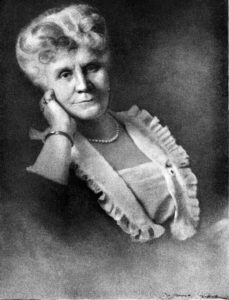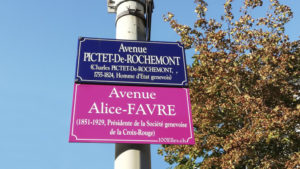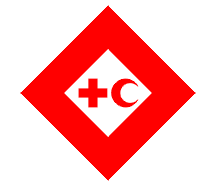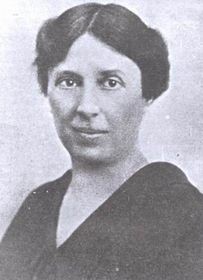1851-1929, Présidente de la Croix-Rouge genevoise
[The following is taken from “100 Elles” a website dedicated to remembering a number of important women. After that text, other material is appended, before the sources etc. given by 100 Elles are placed at the very end of the entry]

“Née le 3 mars 1851 à Genève et décédée le 2 février 1929 au même endroit, Alice Favre est la fille d’Edmond Favre, colonel et écrivain militaire, et d’Henriette Sarasin, de profession inconnue. Alice Favre est une philanthrope impliquée dans la Croix-Rouge genevoise à la fin du 19ème siècle et jusqu’à l’entre-deux-guerres. Elle en est la présidente de 1914 à 1919.
Malgré les origines d’Alice Favre, qui grandit dans la haute bourgeoisie genevoise, très peu d’informations sont disponibles sur sa vie et les historiens et historiennes ne se sont encore que peu intéressés à son parcours.
Elle aurait passé ses jeunes années dans la villa La Grange, la maison familiale qui se trouve encore aujourd’hui au milieu du parc de la Grange. C’est dans cette maison qu’en 1864 un gala est organisé en l’honneur des diplomates chargés de la signature de la convention de Genève qui inaugure les bases du droit humanitaire en temps de guerre.
À cette époque, Alice Favre a 13 ans, et cet évènement fut peut-être sa première expérience avec l’organisation qui allait devenir sa vocation.
Dès 1889, Alice Favre s’investit au sein de la Société des dames de la Croix-Rouge genevoise et, en 1899, elle en devient la présidente. Grâce à son engagement humanitaire, elle voyage beaucoup, Saint-Pétersbourg en 1904 ou Washington en 1912, et s’exprime publiquement lors de différents congrès internationaux de la Croix-Rouge.
À l’époque, le comité de la Croix-Rouge genevoise est divisé en deux sociétés distinctes, l’une féminine et l’autre masculine. Dans ce cadre, les femmes s’occupent principalement de l’aide pratique, notamment en récoltant du matériel pour les blessés, comme des pansements ou du linge. Elles créent également un établissement d’infirmières qui travaillent avec les médecins. Les hommes sont plutôt chargés de la récolte de financement et de subventions.
En 1914, les deux sociétés fusionnent pour devenir la Section genevoise de la Croix-Rouge suisse. L’organisation est alors composée d’une grande majorité de femmes, avec 960 membres féminines et 186 membres masculins. C’est Alice Favre qui en devient la présidente.
D’après le journal Le mouvement féministe, elle est, en 1929, « la seule femme, sauf erreur, qui ait occupé un poste de cet ordre en Suisse ». Ce journal précise aussi qu’Alice Favre représente la Croix-Rouge suisse durant les assemblées générales de l’Alliance nationale des sociétés féminines suisses et qu’elle prend part à la première campagne suffragiste à Genève en 1914.
Pendant la guerre, Alice Favre et la Croix-Rouge genevoise organisent l’accueil des réfugiés et soldats à Genève. Elle met également en place des paquets de Noël pour les soldats suisses en poste à la frontière.
Et quand la guerre se termine, en 1919, son engagement ne s’arrête pas pour autant. Elle rejoint le Comité central de la Croix-Rouge suisse et dirige un nouveau programme d’activités qui comprend notamment la création d’un dispensaire d’hygiène sociale à Genève, réinventant ainsi le rôle de la Section genevoise en tant de paix qui prend une direction sociale et locale.
Alice Favre écrit aussi beaucoup, et quelques années avant sa mort, en 1924, elle publie Pensées sur la vie, un livre qui est le résultat de ses réflexions et qui reprend des lettres qu’elle adressait au Journal de Genève pour partager ses opinions.
À l’occasion de sa mort en 1929, Alice Favre reçoit les honneurs de plusieurs personnalités et journaux qui lui consacrent des notices nécrologiques fournies. L’une d’elles dit même : « [i]l restera […] maintes traces de l’activité qu’Alice Favre a déployé [sic] dans divers domaines et pendant tant d’années ».
Mais aujourd’hui, Alice Favre est une personnalité dont l’histoire reste encore à écrire, et pour qui les informations retrouvées sont très lacunaires. À l’occasion des 130 ans de la Société des dames, la Croix-Rouge genevoise rendra hommage à Alice Favre au travers d’un évènement le 14 novembre 2019.
– – – – – –
Alice Catherine Favre was, as noted above, born in Geneva Monday 3 March 1851[i]. Her parents were Guillaume Favre, député du Conseil représentatif de Genève (1770-1851) (Lieutenant-colonel, érudit et historien) and Catherine Marguerite Bertrand (1782-1842). The two had been married in Geneva Monday 14 November 1842. Alice had two brothers, both older than herself: Camille Alphonse Favre, colonel de l’Armée suisse (1845-1914) Marié le 16 mai 1876 (mardi), Genève, Genève, Suisse, avec Louise Pauline Félicie de Seigneux (1854-1919) ; and William Victor Favre (1843-1918).
In 1902, in her capacity of chair of the Ladies’ Red Cross Society in Geneva, proposed to create a single Red Cross organization in the city and canton. According to the ICRC’s Review[ii]:
« UNION DES SOCIETES GENEVOISES DE LA CROIX-ROUGE
A la suite de l’assemblée générale de la Société genevoise des Dames de la Croix-Rouge, sur la proposition de la présidente, Mlle Alice Favre, et sur une base élaborée par M. le Dr Braun, les trois sociétés existant à Genève et poursuivant un but analogue ont décidé’ de créer entre elles une Union dirigée par un comité spécial. Ces trois sociétés sont : la Société genevoise des Dames de la Croix-Rouge, qui n’etait point rattachée jusqu’alors à la Société centrale suisse de la Croix-Rouge ; la Société des Samaritains, qui est une section de cette dernière ; enfin la section de Messieurs de la Croix-Rouge suisse, qui en fait également partie comme indique son titre.
Cette organisation nouvelle, qui se rattachera a la transformation salutaire que subira la Croix-Rouge suisse, si elle obtient des Chambres fédérales l’allocation annuelle qu’elle a demandée, laissera aux sociétés existantes leur activité et leur autonomie propres ; mais elles constitueront une Société cantonale genevoise de la Croix-Rouge suisse, ayant à sa tête un comité spécial. Celui-ci a déjà été désigné et charge de poursuivre dans cette voie la coordination et l’alliance des sociétés existantes. Son bureau est composé de M. le Dr Wartmann-Perrot, président ; Mlle Alice Favre, vice-présidente ; M. le Dr Braun, vice-président; M. Maurice Dunant, secrétaire; M. Ch. Ackermann, trésorier.
« Mademoiselle Alice Favre, Présidente de la Société des Dames Génevoises de la Croix- Rouge » participated in the VIIIth International Conference, which took place in London in 1907. A highlight, perhaps, was a banquet given by the Council of the British Red Cross in the evening of Friday 14 June with dinner “servi a huit heures dans la Grande Salle de l’Hôtel Cecil, somptueusement décoré[iii]”

Alice Favre also participated in the Xth International Conference which was organized in Geneva in 1921, the first after the World War. She was there in her capacity of “présidente d ’honneur de la Section genevoise de la Croix-Rouge Suisse » and member of the Swiss Red Cross delegation.
One of the subjects debated at this Conference was the relationship between National Societies, and the extent to which one National Society should have the right to act in another country where another National Society had been created. This debate would lead to the so-called “1921 Rules”, which has underpinned international work of National Societies in the nearly one century that has passed, and which were also a key element in the eventual resolution of the “Emblem Question” in 2005/2006.
During this Conference[iv], and on the subject of « Sections étrangères de Croix-Rouge sur territoire national », Alice Favre took the floor when the following paragraph of the proposed decision was debate:
« M. le PRÉSIDENT. — Le paragraphe 2 est ainsi conçu : « Les Comités centraux sont invités à accorder cet agrément dans la plus large mesure lorsqu’il sera avéré que la section étrangère travaille exclusivement auprès de ses nationaux. En cas de désaccord, les Comités centraux pourront en référer à l’autorité suprême de la Croix-Rouge internationale. » La parole est à Mlle Favre.
Mlle FAVRE (Suisse). — Je désire avoir une explication sur les mots : « La section étrangère travaille exclusivement auprès de ses nationaux. » Cela signifie-t-il que la section étrangère s’occupera exclusivement de ses nationaux, ou qu’elle accomplira sa mission exclusivement avec ses propres ressources ? Si ces sections étrangères font appel aux ressources des pays dans lesquels elles travaillent, elles peuvent drainer à leur profit des subventions et des sources de revenus, et épuiser les ressources des Croix-Rouges nationales. Je demande qu’il soit ajouté au texte les mots : « avec ses propres ressources. »
M le PRÉSIDENT. — La proposition reviendrait à dire que les sections étrangères n ’auraient pas le droit de faire des collectes sur le territoire de la nation où elles sont installées.
M VINCI (Italie). — Il ne faudrait pas qu’il y ait confusion. Mlle Favre veut que les sections étrangères travaillent seulement pour leurs propres nationaux. Sur ce point nous sommes d’accord. Mais le secours qu’elles porteront ne profitera-t-il qu’aux ressortissants étrangers ? Nous ne pouvons pas l’admettre. Notre travail à l’étranger est un travail complémentaire.
J’estime que nous avons le droit et le devoir de compléter nos ressources au moyen de subventions locales dans les pays étrangers où nos sections sont établies. Mais nous estimons que nos nationaux à l’étranger rendant des services au pays qui a recours à eux, la Croix-Rouge locale doit aussi les secourir. C’est le principe qui a toujours régi toutes les œuvres de bienfaisance. Notre pensée a été que chaque Croix-Rouge nationale doit prendre la protection de ses propres nationaux et si une organisation étrangère veut s ’en occuper également, elle a le devoir de demander l’autorisation de la Croix-Rouge nationale. C’est pourquoi nous avons dit que les sections étrangères travailleront exclusivement en faveur de leurs propres nationaux. Il me semble que ce texte est clair.
Mlle FAVRE (Suisse). — S’il y a cinq, six ou sept Croix-Rouges étrangères qui viennent s’établir dans une ville, elles drainent tout l’argent et il n’en reste plus pour la Croix-Rouge nationale.
M le PRÉSIDENT. — Je mets aux voix l’amendement de Mlle Favre tendant à ajouter dans le deuxième paragraphe, après les mots « travaille exclusivement auprès de ses nationaux » ceux-ci : « avec ses propres ressources ».
(L’amendement, mis aux voix, n ’est pas adopté.)
M le PRÉSIDENT. — Je mets aux voix le deuxième paragraphe.
(Le deuxième paragraphe, mis aux voix, est adopté.) »
Alice did not participate in the following International Conference, the XIth which took place in Geneva, but in 1925, when the XIIth International Conference took place, also in Geneva, in 1925, « Mlle Alice Favre, de la section genevoise de la Croix-Rouge suisse » was present as a guest[v].
Alice Favre died, 77 years of age, in Geneva on Saturday 2 Februar 1929.
In 2019, 90 years after she passed away, the Geneva Red Cross caused a plaque to be placed in Avenue Pictet-de-Rochemont:

– – – – – –
[Again, from 100 Elles].
Œuvre
- Pensées sur la vie, Genève, Sonor, 1924.
Sources
- Société Genevoise des Dames de la Croix-Rouge, Rapport pour l’année 1898 présenté par Mlle Alice Favre, 17 février 1899, in Société genevoise des dames de la Croix-Rouge 1890-1913.
- Section genevoise de la Croix-Rouge suisse, Rapport pour l’année 1914 présenté par Mlle Alice Favre, 14 avril 1914, in Section genevoise de la Croix-Rouge suisse, rapport 1914-1919, Mlle. A. Favre, présidente.
- S.A, « Celles qui disparaissent : une ancienne présidente de la Croix-Rouge genevoise Mlle Alice Favre », Journal de Genève, 5 février 1929.
- Dr. M., « Mademoiselle Alice Favre », Revue mensuelle de la Croix-Rouge suisse, 1er mars 1929.
- E. GD, « In memoriam : Mlle Alice Favre », Le mouvement féministe, vol. 17, 1929.
Bibliographie
- « Alice Favre », in Observatoire des élites suisses. Base de données des élites suisses au XXème siècle, (http://www2.unil.ch/elitessuisses/index.php?page=detailPerso&idIdentite=74526).
– – – – – –
[i] Geneanet ; https://gw.geneanet.org/rossellat?lang=fr&p=alice+catherine&n=favre&oc=1
[ii] https://international-review.icrc.org/sites/default/files/S1816968600007994a.pdf
[iii] HUITIÈME C o n f é r e n c e In t e r n a t i o n a l e DE LA CROIX-ROUGE TEN U E À LONDRES du 10 au 15 J U I N 1907. COMPTE – RENDU; p 502; https://library.icrc.org/library/docs/DIGITAL/CI_1907_RAPPORT.pdf
[iv] Dixième Conférence Internationale de la Croix-Rouge tenue a Genève du 30 Mars au 7 Avril 1921 ; PP 141-142 ; https://library.icrc.org/library/docs/DIGITAL/CI_1921_RAPPORT.pdf
[v] DOUZIÈME CONFÉRENCE INTERNATIONALE DE LA CROIX-ROUGE TENUE A GENÈVE du 7 au 10 octobre 1925, Compte Rendue ; p 21, https://library.icrc.org/library/docs/DIGITAL/CI_1925_RAPPORT.pdf

